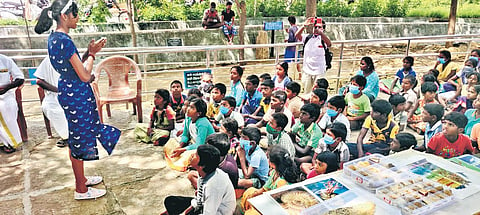

CHENNAI: Chennai-based Aswatha Biju was only five years old when she was introduced to the field of palaeontology through the picture of an ammonite fossil in The New Children’s Encyclopedia, her father’s gift. The interest soon bloomed when she visited the Government Museum in Egmore. Now, in class 9 at Sri Chaitanya Techno School, she is conducting seminars for her peers and adults, as she did on December 5 for DakshinaChitra’s heritage week series. “When I came to know that the field of paleontology is less familiar with the citizens of India, I set out to raise awareness about the same. I came up with a solution and eventually gave my first museum seminar to college students,” she begins.
With an impressive sample collection of 136 fossils — invertebrates, vertebrates, chordates, florae — Aswatha has worked on three fossil beds in India, namely Ariyalur, Sironcha and Gunduperumbedu. “The majority of fossils you find in Ariyalur in Tamil Nadu are microcosms, marine invertebrates, and flora. In Gunduperumbedu (TN), you can find lots of fossilised upper gondwana leaf samples that belong to the Mesozoic era and aged 113-125 million years. These samples stretch from Tamil Nadu all the way to the Nepal border,” she notes.
But what exactly does a paleontologist do? Aswatha gives a short brief — visiting the field, mapping, cleaning and identifying specimens, calculating latitude and longitude, transforming them into containers, removal of matric, marking the specimen and safeguarding.
“Morphological traces show how creatures survive. When the habitat changes, organisms’ behaviour and characteristic features change as well. This is morphological evolution. This also created a change in food habits. For example, when mountainous organisms change their habitat to desert or ocean habitat, the body, too, changes and adapts to marine conditions,” she elaborates. These morphological traces help us support our theories and understand evolution, she adds.
As the world becomes more and more modern and advanced, what is the need to look back in the way palaeontology does? The key point is that the present day, high-rated technology we have the classic building and architecture; in the history of each of these, palaeontology is involved, she shares. The creatures of today cannot be compared to those of the past.
“For example, predators in the past were unique — in their armoured body, hunting strategy and arrangement of body. All these have led to the evolution and revolution in these sectors we face together. The spiral shape come from the cross-sections of the ammonite; they have chamber-like structures. This is why we must study palaeontology for modern life,” suggests Aswatha. We tend to understand climate, temperature, ecology, and environment through palaeontology; essential to understand from years ago.
With detailed information and convincing arguments, Aswatha’s talk gives an insight of the need for awareness of palaeontology in India.